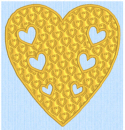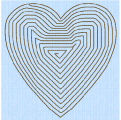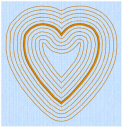Any area can have a border, or no border. The border can be closed or open, and it can use any line type. Holes can be defined inside any fill area. Appliqué properties may be set for any area or line. Use Break Apart on the Object menu to change an area with a border into separate fill area and line objects.
Note: Any fill area can be converted into a Satin Area, however any holes in the fill area will be lost.
Pattern Fill
Pattern Fill areas ![]() contain small stitches with repeating patterns from an origin point that can be moved. Select from one of the themed collections. A pattern fill area can have holes defined inside it. The stitches can be at any angle and the density can be constant, gradient or multicolor as desired. Constant density fill areas can also have automatic underlay, which is turned off automatically for gradient density areas.
contain small stitches with repeating patterns from an origin point that can be moved. Select from one of the themed collections. A pattern fill area can have holes defined inside it. The stitches can be at any angle and the density can be constant, gradient or multicolor as desired. Constant density fill areas can also have automatic underlay, which is turned off automatically for gradient density areas.
|
|
|
|
|
Fill Area with Satin border and holes using Pattern Fill 109 from Hearts |
Pattern Fill Area with Multicolor Gradient |
Motif Fill Area with two motifs, 13 and 19, from Hand Stitches 2 |
Note: If you change a gradient density fill back to standard, then you should also select the desired underlay.
Motif Fill
Motif Fill areas ![]() contain repeated small stitches placed using one of the Universal or machine motif patterns. A motif fill area can also have holes defined inside it. The motifs can be at any angle and at different sizes, and different motifs can be used on alternating lines.
contain repeated small stitches placed using one of the Universal or machine motif patterns. A motif fill area can also have holes defined inside it. The motifs can be at any angle and at different sizes, and different motifs can be used on alternating lines.
Shape Fill
Shape Fill areas ![]() use one of 120 different shapes from an origin point that can be moved. Vary the stitch density, use running stitch or motif lines for the fill and add holes.
use one of 120 different shapes from an origin point that can be moved. Vary the stitch density, use running stitch or motif lines for the fill and add holes.
|
|
|
|
|
Shape Fill Area using Shape 23 and Motif 1 from Hand Stitches 1 |
Radial Fill with origin moved to top of heart |
Spiral Fill using Gradient Density |
Radial Fill
Radial Fill areas ![]() use a pattern of radiating lines from an origin point that can be moved. Vary the stitch density and add holes.
use a pattern of radiating lines from an origin point that can be moved. Vary the stitch density and add holes.
Spiral Fill
Spiral Fill areas ![]() use a spiral pattern from an origin point that can be moved. Use constant or gradient density, and add holes.
use a spiral pattern from an origin point that can be moved. Use constant or gradient density, and add holes.
QuiltStipple Fill
QuiltStipple Fill areas ![]() use stipple stitch in curved or straight lines. Vary the gap between stitch lines, use running or triple stitch, and add holes.
use stipple stitch in curved or straight lines. Vary the gap between stitch lines, use running or triple stitch, and add holes.
|
|
|
|
|
QuiltStipple Fill using a curved style |
Contour Fill, using Triple Stitch and a 3.0mm gap |
Crosshatch Fill, using Diamond style and an Angle of 75 degrees |
Contour Fill
Contour Fill areas ![]() use contour stitch lines. Vary the gap between stitch lines and the length of the stitches, use running, double or triple stitch, and add holes.
use contour stitch lines. Vary the gap between stitch lines and the length of the stitches, use running, double or triple stitch, and add holes.
Crosshatch Fill
Crosshatch Fill areas ![]() use diamond, square and parallel crosshatch patterns, or select the angles for the crosshatch. Set the gap, style, line angle, stitch type and stitch length for the crosshatching, and add holes to the fill.
use diamond, square and parallel crosshatch patterns, or select the angles for the crosshatch. Set the gap, style, line angle, stitch type and stitch length for the crosshatching, and add holes to the fill.
Note: Crosshatch fill is often selected for lace designs, typically using a Double Zigzag stitch type.
Curved Crosshatch Fill
Curved Crosshatch Fill areas ![]() use curving lines in the crosshatch, which can be used to create a feeling of depth. They are used in quilting, and to create free-standing lace.
use curving lines in the crosshatch, which can be used to create a feeling of depth. They are used in quilting, and to create free-standing lace.
|
|
|
|
|
Curved Crosshatch Fill, using Square style and a Gap of 5mm |
MultiWave Fill, using a density of 15, a MultiWave Line, and a Hand Stitches 1, Pattern 1 motif |
Echo Fill using Internal and External Lines, and rounded corners |
MultiWave Fill
MultiWave Fill areas ![]() use a wave pattern defined by a line, or lines, drawn on the fill area. Vary the density, or use a motif for the stitch lines.
use a wave pattern defined by a line, or lines, drawn on the fill area. Vary the density, or use a motif for the stitch lines.
Echo Fill
Echo Fill ![]() places echo lines within and/or around a shape. Choose from rounded, square and diagonal corners, set the gap between the echo lines and the number of lines, and select the stitch type and length.
places echo lines within and/or around a shape. Choose from rounded, square and diagonal corners, set the gap between the echo lines and the number of lines, and select the stitch type and length.
Satin Areas
Satin Areas ![]() contain zigzag stitches that fill the area from one end to the other at the same density. The stitch angle changes with the shape of the area, and can be adjusted as desired. Choose automatic edge walk and/or zigzag underlay.
contain zigzag stitches that fill the area from one end to the other at the same density. The stitch angle changes with the shape of the area, and can be adjusted as desired. Choose automatic edge walk and/or zigzag underlay.
Note: Satin Areas can be converted into any type of fill area. They cannot be created with a border, but a border can be placed around them using the Area Properties dialog.











